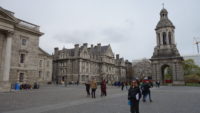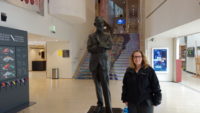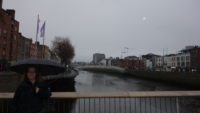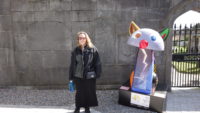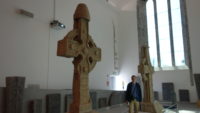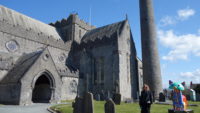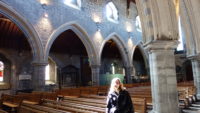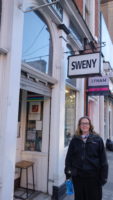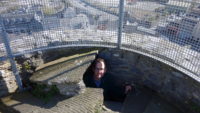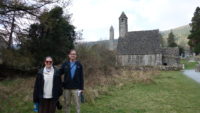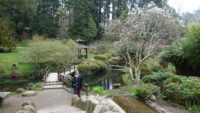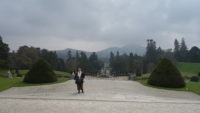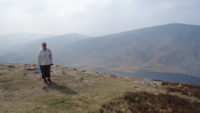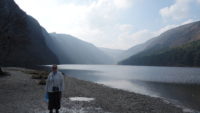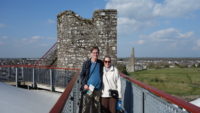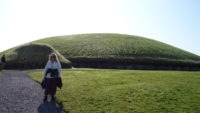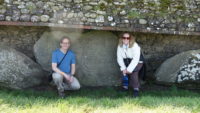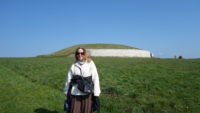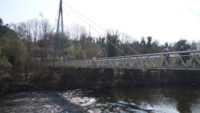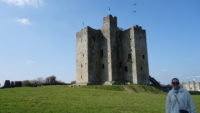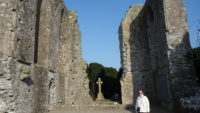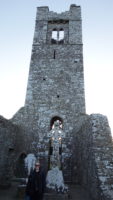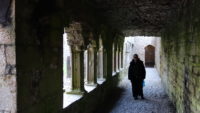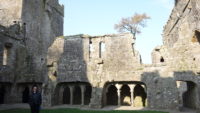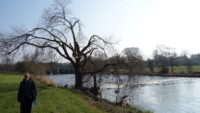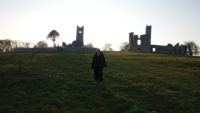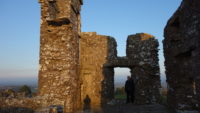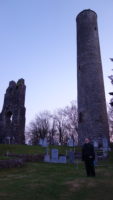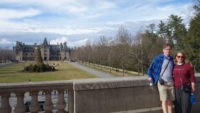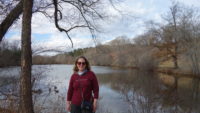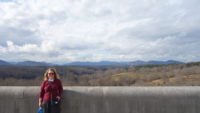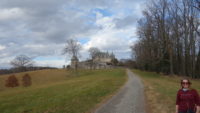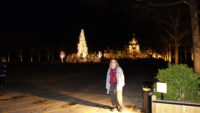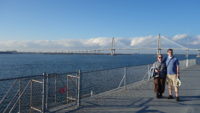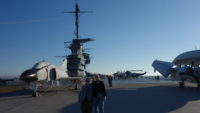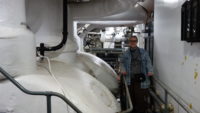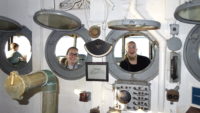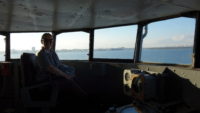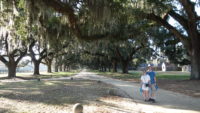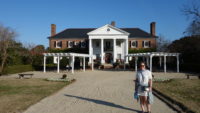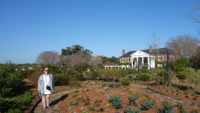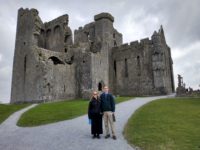 Some days I am confronted with getting older. That can be in healing slowly or having minor pains in back, neck, and elsewhere. But more and more it means being clumsy (dropping things and tripping) and forgetting things. Like forgetting to get gas.
Some days I am confronted with getting older. That can be in healing slowly or having minor pains in back, neck, and elsewhere. But more and more it means being clumsy (dropping things and tripping) and forgetting things. Like forgetting to get gas.
We set off happily this morning from our B and B, headed to the supposed-to-be impressive Rock of Cashel. We got a little bit of a late start, but I wasn’t on a strict timeline, so that was okay. Until I glanced at the gauges and suddenly remembered that I had forgotten to get gas last night. I figured we would pass a gas pump at least (if not a full station), but back lane Ireland is really rural. After not seeing any place to get gas, I told my GPS to find a station. It did. Five miles away. Which would take twenty minutes. Sigh.
 We did make it to the pump (not a station). There was a man filling a two-gallon container while talking to another man leaning against a car. We waited. The leaning man drove off, and we pulled up. The attendant (it was a full-serve pump) and I had (roughly) the following conversation:
We did make it to the pump (not a station). There was a man filling a two-gallon container while talking to another man leaning against a car. We waited. The leaning man drove off, and we pulled up. The attendant (it was a full-serve pump) and I had (roughly) the following conversation:
Attendant: Cead failte mile!
Me: Ummm. Hello.
Attendant: Easel or undead?
Me: Ummm. (waves keychain in air that says “Unleaded only”) Unleaded?
Attendant: Tan or twenney?
Me: Ummm. Twenty?
Attendant (pumps gas): Sinead O’Connor mulligan lucky charms erin go bragh guinness craic gob my left shoe U2 bork bork bork. Heh! Ha!
Me (nervously): Ummm. Yeah. (laughs nervously, gets back in car, and drives away with a modicum of gas in tank)
We did eventually get to the Rock of Cashel. Even from the parking lot, it looked impressive. We got out of the car, and I reached for my camera. Enter old-fart moment number two. I had no camera. It was an hour away in my B and B room. Sigh. Happily for me, I did have my travel smartphone with me, and that filled in for my camera for today. Still, not an encouraging moment. It goes down at the third time I’ve blown it with my camera (not charged for Venice’s Burano island, forgotten for Seydisfjordur in Iceland, and now forgotten for Cashel).
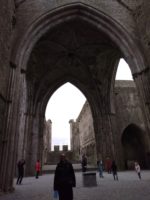 The Rock of Cashel looked like to me like a castle, but it is not. The Rock is the rocky hill on which a fortress-looking church complex is built. It used to be a fortress of the king of Ireland, but in 1100, he decided to move his court. But, since his family had taken the Rock from another family, he did not want the other family grabbing it and trying to set up a rival kingdom. So, in a savvy political move, he gave the entire Rock to the church. He gets favorite-son status with the local church, and his rivals can’t try to take the Rock from the church. The church started building a chapel almost immediately.
The Rock of Cashel looked like to me like a castle, but it is not. The Rock is the rocky hill on which a fortress-looking church complex is built. It used to be a fortress of the king of Ireland, but in 1100, he decided to move his court. But, since his family had taken the Rock from another family, he did not want the other family grabbing it and trying to set up a rival kingdom. So, in a savvy political move, he gave the entire Rock to the church. He gets favorite-son status with the local church, and his rivals can’t try to take the Rock from the church. The church started building a chapel almost immediately.
That is a remarkable church, too. It’s from around 1200, and it is the first Romanesque church in Ireland, and remarkably, it is intact to this day. It had to be refurbished a few years back because the sandstone of which it is made had become waterlogged over nine hundred years. The Office of Public Works built a temporary roof over the whole church for five full years, and that let the stone dry out. They then tore the roof off stone by stone, and replaced twenty percent of the roof’s stones with identical ones, and put the whole thing back together with a thin waterproof lining underneath. Slick.
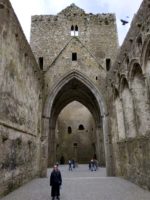 We were able to go inside the church on our pay-for tour, and while the inside is simple and small (it was a private church for the archbishop), it is nine hundred years old, and there are still small pieces of frescoes on the ceiling, and the carved decorations are still intact. That kind of age is a bit mind-boggling.
We were able to go inside the church on our pay-for tour, and while the inside is simple and small (it was a private church for the archbishop), it is nine hundred years old, and there are still small pieces of frescoes on the ceiling, and the carved decorations are still intact. That kind of age is a bit mind-boggling.
After the chapel tour, we took a tour of the rest of the buildings, which are mostly the roofless cathedral (from around 1200) and an intact round tower (which may be as old as being built in 900). The guide said the cathedral was small even by the standards of the time, but all of Ireland only had half a million people. It didn’t need to be big. I thought it looked huge.
We found out about a bishop of Cashel from the 1500s who somehow managed to be both a Catholic bishop (for the north) and a Protestant bishop (for the south). He was finally excommunicated after ten years, but he still somehow managed to have three wives and twenty-seven children (that we know of). He was described as a tall and handsome man. Seems he used that to his advantage.
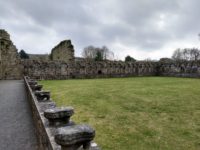 After the tour was over, we drove an hour back to the Kilkenny region to go see the Jerpoint Abbey. Yes, another ruined abbey. This one is well known for the carvings left behind by the monks who weren’t supposed to have carvings (they weren’t all allowed by their order). No one is sure if the monks just disobeyed the rule or if the rule eventually got relaxed, but the many of the carvings still survive. It is also a large church, and we had it to ourselves, which was pretty fun.
After the tour was over, we drove an hour back to the Kilkenny region to go see the Jerpoint Abbey. Yes, another ruined abbey. This one is well known for the carvings left behind by the monks who weren’t supposed to have carvings (they weren’t all allowed by their order). No one is sure if the monks just disobeyed the rule or if the rule eventually got relaxed, but the many of the carvings still survive. It is also a large church, and we had it to ourselves, which was pretty fun.
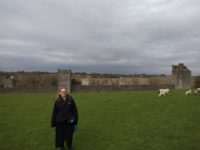 The last stop of the day was…wait for it…another ruined abbey. We went to the Kells Priory complex (not that Kells – another one). It is simply huge, and it is free to see, and we had it to ourselves except for one woman walking her dog on the other side of the complex. I’m not sure what all they did at the Priory, but it involved a substantial defensive wall and dozens of buildings. Mer and I think we found the main church, but it was small compared to the size of the place. It was windswept and lonely and quite marvelous, and as a bonus, we got to see dozens of frolicking lambs in the field through which we had to walk.
The last stop of the day was…wait for it…another ruined abbey. We went to the Kells Priory complex (not that Kells – another one). It is simply huge, and it is free to see, and we had it to ourselves except for one woman walking her dog on the other side of the complex. I’m not sure what all they did at the Priory, but it involved a substantial defensive wall and dozens of buildings. Mer and I think we found the main church, but it was small compared to the size of the place. It was windswept and lonely and quite marvelous, and as a bonus, we got to see dozens of frolicking lambs in the field through which we had to walk.
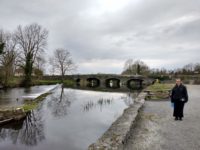 We went back to the mill restaurant at which we ate last night, since it was only a mile away, and then got back to our B and B early. We may head out to see if we can find a pub with music, or we may use the evening to get some rest. Either way, compared to what we saw today, I’m feeling pretty young.
We went back to the mill restaurant at which we ate last night, since it was only a mile away, and then got back to our B and B early. We may head out to see if we can find a pub with music, or we may use the evening to get some rest. Either way, compared to what we saw today, I’m feeling pretty young.
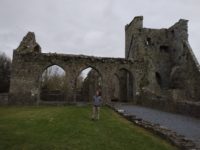 Shocking postscript – I went out on the town, in the evening, voluntarily, until 11:00 pm. We went to a tiny pub called The Hole in the Wall in downtown Kilkenny. What a gem. Mer and I walked into the downstairs of the pub, which had about eight seats. We were the only customers. Although I was looking for music, it was too cozy a place to pass up, so we sat down and started chatting with the owner, who is also a cardiologist. While we were chatting, a local couple came in and joined in. We were then eventually joined by four Swedish college students. That was it, for the entire evening. Eight of us and the owner, all chatting, until the Swedes offered to sing. They sang a song in Swedish, and then did an enthusiastic Irish song. We ended up with someone providing music (including Meredith leading “Amazing Grace”) for the rest of the evening. I sadly called our evening over at 10:30 pm. I would have happily stayed until closing. What a pure joy the night was. If you are ever in Kilkenny, please look up The Hole in the Wall – it’s a little tricky to find (it’s down an alley), but it is worth it.
Shocking postscript – I went out on the town, in the evening, voluntarily, until 11:00 pm. We went to a tiny pub called The Hole in the Wall in downtown Kilkenny. What a gem. Mer and I walked into the downstairs of the pub, which had about eight seats. We were the only customers. Although I was looking for music, it was too cozy a place to pass up, so we sat down and started chatting with the owner, who is also a cardiologist. While we were chatting, a local couple came in and joined in. We were then eventually joined by four Swedish college students. That was it, for the entire evening. Eight of us and the owner, all chatting, until the Swedes offered to sing. They sang a song in Swedish, and then did an enthusiastic Irish song. We ended up with someone providing music (including Meredith leading “Amazing Grace”) for the rest of the evening. I sadly called our evening over at 10:30 pm. I would have happily stayed until closing. What a pure joy the night was. If you are ever in Kilkenny, please look up The Hole in the Wall – it’s a little tricky to find (it’s down an alley), but it is worth it.
Off to bed. Oh – for those keeping count, ten abbeys and one castle on this trip.
